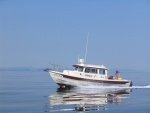Excellent and interesting article I had read the last week. Navigation in the Viking era was by sailing "Equal Latitudes". There was no compass, and celestial navigation as we know it was very primitive. It was mostly based on a primitive sun dial, and thus the angle of the sun with the horizon. You would head to the latitude of your destination as determined by the elevation and bearing of the sun. During clear weather this was reasonably easy. But during bad weather, frequent in the North Atlantic, it was a problem to determine the exact position of the sun. The article describes how they took readings of the azimuth of the sun using crude polarized crystals, during overcast weather, using a second image of polarized light. The more frequent the sights, the more accurate the landfall. Also the important of use of all senses; wind direction, taste (water and sea bottom) smell, swell direction, birds, sea life and some known coastal geographic features all entered in.
We also know that the Vikings had some knowledge of the position of the stars, at various times of the year, and used these at night when visible. There was no time keeping, nor measure of speed; although time of sunrise, Zenith of the sun at celestial noon and sunset were also noted, and I suspect utilized.
If they went too far South of Greenland, then the next body of land was North America (Newfoundland) if they didn't perish on the way. --and thus the early voyages to the North American Continent long before Columbus.
The theory of the sunstones theory had been postulated for some time, but the most recent publications outlines some research involving plotting1000 voyages (on simulators). The findings were that if sightings were taken at least every 3 hours, that over 92% of the time the voyage would have reached the destination

